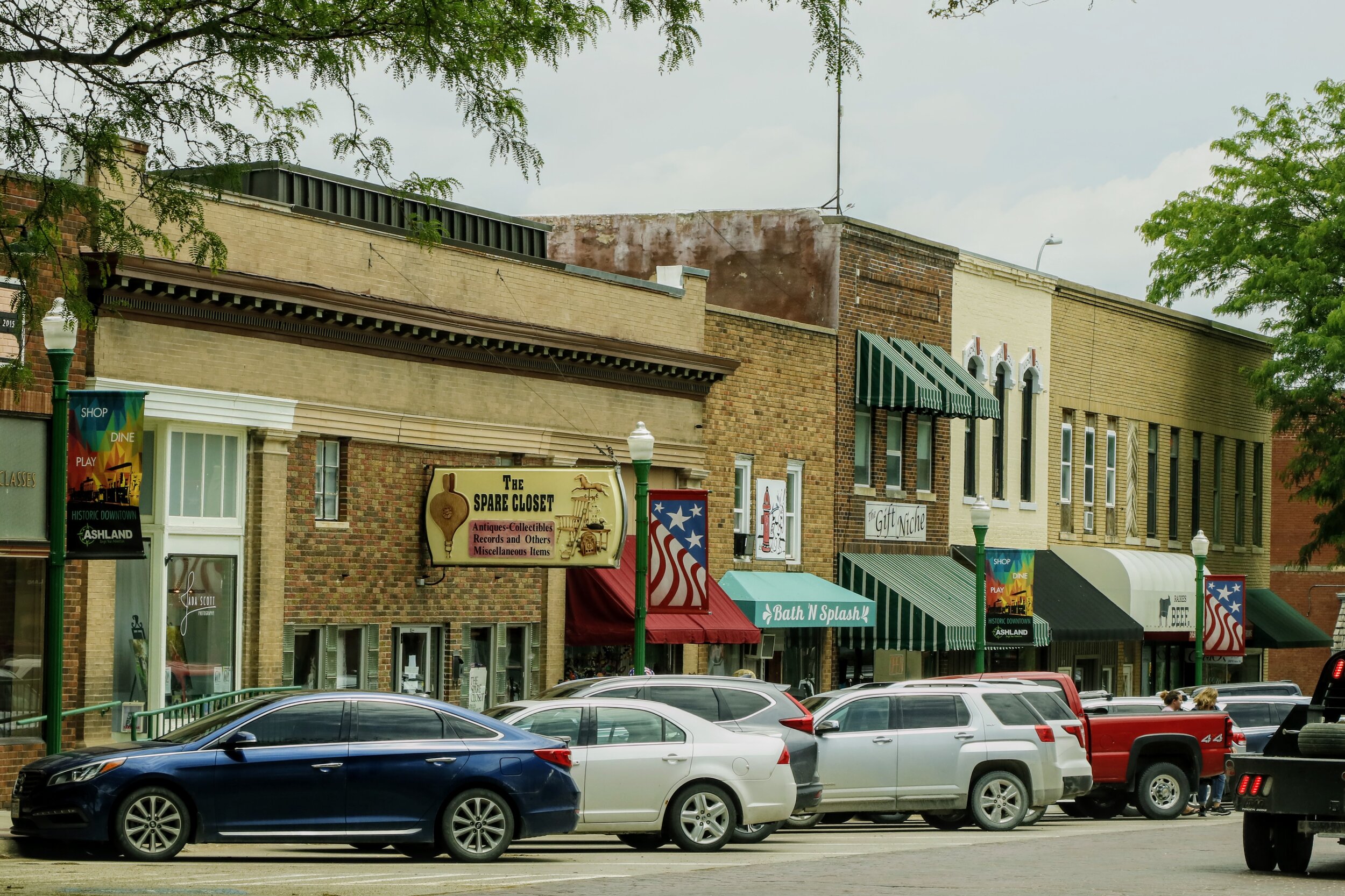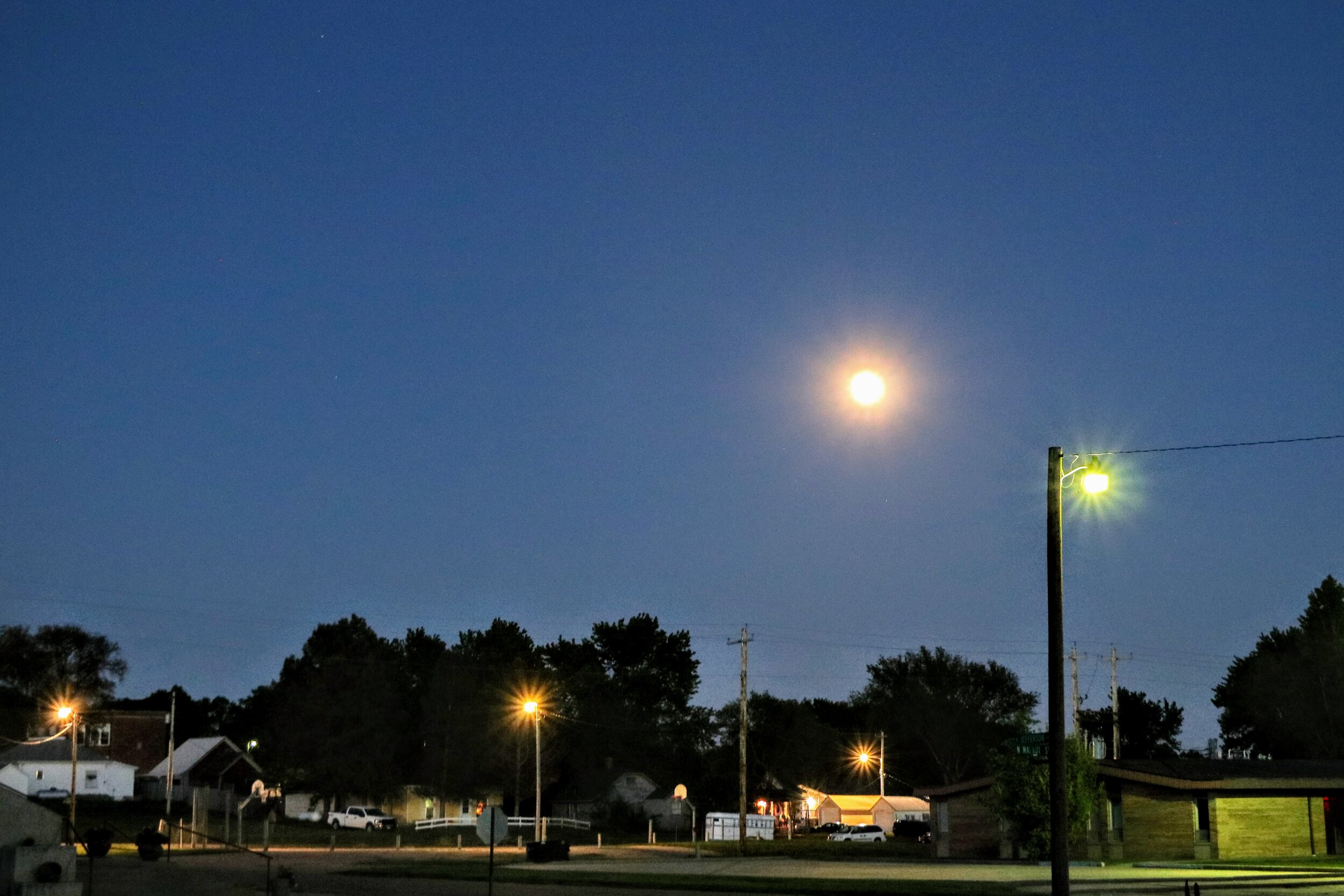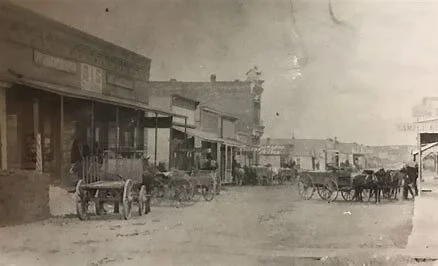NEBRASKA
Population (2018): 1.9 million Square miles: 77,421 Covid vaccinated (Sept. 2021): 66% Percentage white people: 88%
“Where, Oh where is the West that Easterners dream of—the West of Bret Harte’s stories, the West depicted in the moving pictures? Are the scenes no longer to be found except in the pages of a book, or on a cinematograph screen? We have gone half the distance across the continent and all this while we might be anywhere at home.” — Emily Post, By Motor to the Golden Gate (1916)
Omaha
Population: 479,978
“Omaha … is an impressively up-to-date city with many fine new buildings, important dwellings and beautiful avenues on which, last by not least, motors are made hospitably welcome. In nearly all Eastern cities automobiles are treated as if they were loitering tramps; continually ordered by the police to “keep moving along.” In Omaha the avenues are so splendidly wide that they can afford chalked-off parking-places in the center of the streets where motors can stand unmolested and indefinitely. If only New York and Boston had the space to follow their example!” — Emily Post, By Motor to the Golden Gate (1916)
Trevor, host, bartender, waiter. I mentioned that no one seemed to be walking around downtown. “Is this normal? Is it because of the pandemic?” “No, we get crowds down here sometimes. Last week there was a baseball tournament…”
“But that’s tourists. Where do the locals go, like to shop?”
“We have two malls … “
“But I mean… is there a downtown where people go.”
“Ummm … not really. Omaha’s … not much of a walking city.”
Much as New Yorkers go to Sherry’s or the Ritz, Omaha society seems to come t othe Fontanelle to dine. … A few women look smart, but a number suggest the probability of their having arrayed themselves to take part in tableau vivants, or an amateur fashion parade. A young girl with pink tulle draped around the lower half of her face bent the top edge down gingerly while she ate a few mouthfuls, and then carefully arranged it across the tip of her nose again. It seemd to be another example beside that of banting for thinness, of faut avoir faim pour etre belle. … Among the appropriately and well-dressed women one was superlatively smart. … Her costume is not much to describe: a severely simple gun-metal taffeta one-piece dress with a white organdie collar and sleeves of self-colored chiffon, a wide-brimmed black straw hat turned up at one side of the back with a black bird. … You felt that [her look] belonged to her almost in the way that a collie’s fur belongs to him … — Emily Post, By Motor to the Golden Gate, 1915
I asked Trevor about a cool neighborhood. He suggested Dundee, a small, cool crossroads featuring a coffee shop, cupcake shop, bridal shop, and a movie theater (closed).
So. Imagine the executives of a new quick-stop, at the conference table one morning, tossing out ideas for a new name. “How about Kum & Go!” someone suggested. “Grand idea,” the rest said in chorus. And so it was. Okay then.
Ashland
Population (2019): European Settlement: 18__
Location: Eastern Nebraska, between Omaha and Lincoln on Highway 80
Wiki Sez:
“We arrived at our new home this afternoon at five o’clock, having traveled more than fifty miles in two days in a large express wagon drawn by our two faithful horses, named Tom and Jerry. My first view of this village impressed me so keenly I clapped my hands for joy at the sight of such a pretty town, so neat and so clean.”
— Anna Vaughan Scott, Life on the Prairie: The Diary of a Nebraska Girl, 1871-1875 (1989)
“October 9, 1871 [At school] I also met Josephine and Eugenie Wiggenhorn, girls of my age. They are nice too. They are German and their father has the lumber yard. They have two brothers, Hugo and Edwin.” — Anna Vaughan Scott, Life on the Prairie
Editor’s Note: “Ernest A. Wiggenhorn later sold his lumber business, and in 1883 organized in Ashland the Farmers’ and Merchants’ Bank. Upon his death in 1904 his son Hugo succeeded him as bank president; Edwin became cashier.”
Platte River
Monday, May 13. This day brought us to the crossing of the Missouri River, ten miles below old Fort Kearney, which stands at the mouth of the Platte River. Here we found a number of wagons and the Carson boys waiting to be crossed over in an old-fashioned ferry-boat. Mr. Bullard and Mr. Bray were here with a train of wagons, loaded with merchandise for Salt Lake City. We learned that they are old Santa Fe traders. They were registered to cross first at the ferry, and so they went ahead, as each party must take its regular turn as registered on the ferry-boat. This was known as Bullard’s Ferry.
This was our first night at the camp. Thus far we had staid in a house every night since we left home. We enjoyed the change very much, and really thought we had lost a great deal of comfort in putting up with the miserable accommodations that we so often had met with; for here, on the banks of this majestic river, surrounded with the freshness of the budding spring, it was a delightful change.
We are now six hundred and thirteen miles from home. The elevation of this place is nine hundred and fifty feet above the Gulf of Mexico and about four hundred feet above our old home. So we have already begun to climb.
Tuesday, May 14. We were safely across the wide and muddy-colored stream by eleven o’clock this morning. Now that we are over, and the wide expanse of the great plains is before us, we feel like mere specks on the face of the earth.
I think none of us have realized until now the perils of this undertaking. During the past week not much has been discussed but the Indians and their doings. Printed circulars have been distributed incorming the emigrants of many Indian depredations. Now I begin to think that three men, one woman, and an eleven-year-old boy, only armed with one gun and one Colt’s revolver, are but a small force to defend themselves against many hostile Indian tribes, along a journey of two thousand miles.
Margaret A. Frink, Journal of the Adventures of a Party of Gold-Seekers under the Guidance of Mr. Ledyard Frink During a Journey Across the Plains from Martinsville, Indiana, to Sacramento, California, from March 30, 1850, to September 7, 1850. From the original Diary of the Trip kept by Mrs. Margarent Al Frink. (1897)
Platte River, May 2021
An alternate view. According to Wikipedia:
“More than 15 historic tribes have been identified as having lived in, hunted in, or otherwise occupied territory within the current state boundaries.[1]
The 19th-century history of the state included the establishment of eight Indian reservations, including a half-breed tract. Today six tribes, (Omaha, Winnebago, Ponca, Iowa, Santee Sioux, Sac and Fox), have reservations in Nebraska. In 2006 American Indian and Alaska Native persons comprised one percent of the state's population. Towns at the northern border also have relations with on reservations within South Dakota.”
In 2021, this hallmark of pioneer crossing is appreciated by RV campers — though parking’s prohibited.
Irrigation machines are ubiquitous in Nebraska: lines of wheeled sprinklers like myriad steampunk pterodactyls.
Potter
Population (2018): 306 Established 1870
The Village of Potter was established as the railroad progressing westward. The town was named after General Joseph S. Potter, a Union Pacific Railroad Director. In 1870, Union Pacific built a station house and it served as the post office, the schoolhouse and the land development office. It was the only building build for several years. Progress towards advancement began in 1885, when a hotel was built and shortly after stores began popping up, a newspaper called the Potter Review was created, and a church was built. In 1892 due to a big crop, grain bins were built to hold the oats and wheat the local farmers were growing.
After years of drought and hard times, things began to look up for the community in 1904 when the Kinkaid Amendment was passed. The Kinkaid Amendment was part of the Homestead Act of 1862, and granted a full section (640 acres) to new homesteaders settling in 37 counties in western Nebraska. After the amendment was passed, in 1907 the first bank was organized, and many improvements were done to the community such as installing sidewalks and developing water and electrical systems. During this time the town was incorporated, and by 1915, the town's brick schoolhouse had been built.
During the 1920's the town prospered, a library and a power plant with a second generating unit were built, and a volunteer fire department was formed. In 1929, the Lincoln Highway was built and the original route was through town down Front Street. The route was change to a by-pass on the south side of the tracks to keep noise and traffic through town down.
The community's first Potter Days was held in 1936, and the first prize drawing was a brand new Chevrolet. The tradition of Potter Days continues today, and is held annually over Labor Day weekend. There is a parade, drawings, contests, exhibits and a dance or two.
The Village of Potter is still going strong today and progressing towards the future. Over the years, volunteers have done a lot and continue to do a lot to keep are community alive in the changing times. The residents of Potter take great pride in their community and it shows in many of the projects that have been accomplished over the years. — potternebraska.com
Above: Cheyenne County Historical Society and Museum
Trucks and horse-drawn wagons line up to unload wheat in downtown Potter, 1920. Source: nebraska.gov
Arnold
Population (2019): 802 Platted: 1882 Median household income: $25,500 (2010 census) Host, Sandhills Open Road Challenge, an annual 55-mile car race. In 2017, the SORC website says, donations to “worthy local projects” exceeded $1 million.
Grazers Bar & Grill is a lively spot on West Arnold Avenue. In July the bar sponsors a 4WD Pasture Crawl, barbecue competition, and live music. The main event seems to be exactly what it sounds like: Some 150 Jeep-like vehicles bumping slowly through a hilly, green pasture.
Scene: Grazers Bar & Grill
I sit at the bar, where a friendly blonde woman takes my order. JESSE, a handsome, blue-eyed and chatty guy in his late 40s appears and hands me a Grazers coozie for my beer. This turns out to be JESSE, the bar owner.
JESSE: Where do you come up from?
Me: Today, from Council Bluffs, but I live in North Carolina.
JESSE: Oh, okay. He doesn’t seem to find it unusual for a single woman from NC to have shown up here.
ME: (gesturing at the lively, packed room behind me) This place seems like the hottest spot in town. Is this a normal crowd?
Oh yeah, we get a lot of people come through here.
ME: So did you have to close down this winter (referring to Covid obliquely, as if it’s a dark secret).
JESSE: No we stayed open. The crowds were down though. But in the summer there’s a car race here sponsored by Optima. It’s the biggest event in town. The second Tuesday of August, 11,500 people come.
Glancing around, I notice photos of past winners on the walls.
JESSE: Everyone in town rents out their homes. Last year the cooler quit. It was standing room only in here. We had 2 pool tables, and the patio and parking lot full. This is the 20th year.
A guy with a t-shirt that reads, “Wish you were Beer” appears at the bar.
GUY: Hey, did Ernie leave a branding iron here for me?
JESSE: “Oh yeah it’s right here.
Jesse reaches under the bar, pulls out a long, rusty contraption and hands it to the guy.
JESSE: Y’all branding some new calves?”
GUY: No, [unintelligible] just bought two new bulls so we got to brand em.
JESSE brings GUY a beer. Older man with a creased neck, button-down shirt and brand-new looking, dark blue jeans that look like they could stand up on their own orders two Buds. I catch the tail-end of their conversation above the music and other noise.
OLDER: … Yeah we’re up here for the funeral.
[He gestures to a group behind him: an old woman in a black dress and white cap. Several other women who could be her daughters, also wearing black, but more modern-looking, an assortment of men, all wearing starched blue jeans and nice shirts, and several blond children complete the party. The old woman, I imagine, is the widow. People seem to treat her with a differnt level of respect. She sits quietly with a faint smile, commenting now and then, but mostly her eyes are fixed on the middle distance. She seems calm, at peace, not as if she’s putting on a show of bravery for the other mourners. But who knows.
OLDER: We sure do appreciate you accommodating us.
JESSE: Oh sure of course.
JESSE comes back later to tell me about the bands who’ve played here. He lets drop a few names that I gather are considered household. I don’t recognize a one, but I nod vaguely enthusiastically. I get the impression he’s making a special effort to show that he’s not some hick bar in a hick town. And in fact, I don’t see it that way. I feel comfortable and welcomed without drawing any obvious attention. I get the impression, however, that my presence is noted, but that no one would presume to stare, much less point.
Center School Museum and Guest House, 1892
Oglalla
Original inhabitants: Oglala Lakota* Population (2010) 4,737 European settlement: 1875
According to its website, Oglalla is “a wonderful place to live, work, and play! People of all ages and backgrounds are drawn to the Oglalla area because of the excellent quality of life found here. Oglallah has many things to offer: superior health care, a forward-thinking school system, low crime rate, endless recreational opportunities, a quiet and friendly environment, an inviting business atmosphere, a vast agricultural community, and a rich old-west history.” ogllala-ne.gov
*This area was part of the Oglala Lakota territory, used mostly as a hunting ground. The Fort Laramie Treaty (1868) established the Great Sioux Reservation, which portioned off some land to the Sioux nations and claiming the majority of traditional lands for white settlers. In 1980, the Supreme Court ruled that the treaty illegally took Sioux tribal lands. The Sioux have refused monetary compensation, demanding their land back instead. As of 2018, the compensation amount was more than $1 billion. Today, a majority of Oglala people (47,000 tribal members) live on the Pine Ridge Reservation in South Dakota (Wikipedia).
“Red Cloud was central in organizing resistance against white expansion into Lakota territory. In the 1860s, the Bozeman Trail was being developed by John Bozeman as a shortcut to the Oregon Trail and newfound gold in Montana territory. The trail cut through Lakota lands. In addition, the U.S. government was also building new forts along the trail. Red Cloud worked to unite many different Native tribes, especially the various branches of the Lakota and Cheyenne to defeat the soldiers from Fort Kearny. After two years of war against growing U.S. military forces, miners and settlers, Red Cloud and his warriors forced the military to abandon their forts and stop building the trail.” — notesfromthefrontier.com
“Friends, it has been our misfortune to welcome the white man. We have been deceived. He brought with him some shining things that pleased our eyes; he brought weapons more effective than our own: above all, he brought the spirit water that makes one forget for a time old age, weakness, and sorrow. If you possess these things, you put away the wisdom of your fathers. … My countrymen, shall the glittering trinkets of this rich man, his deceitful drink that overcomes the mind, shall these things tempt us to give up our homes, our hunting grounds, and the honorable teaching of our old men? Shall we permit ourselves to be driven to and fro — to be herded like the cattle of the white man?” — Red Cloud, quoted in Indian Heroes and Great Chieftains, by Charles A. Eastman (Ohiyesa) (gutenberg.org)
Left: Spring Street, Oglalla, 1899
Like many Western frontier towns, Oglalla grew up around the railroad. It was a stop first on the Pony Express, then on the transcontinental railroad. From the mid-1800s to the early 20th century, Oglalla was a terminus for cattle drives from Texas.
In May 2021, Oglallah’s Front Street, right off Interstate 80, was rundown and largely deserted, with many older businesses closed down. Nonetheless, in 2021 the unemployment rate was low (2.2%). The average household income was $36,000; tellingly, future job growth was predicted to be low (17%, versus the U.S. average of 33%). bestplaces.net
Despite its name — and this is nothing new — Oglalla celebrates its frontier past far more than the history of its indigenous inhabitants.
The next street over from Front Street, this grain storage building looms, shoved up next to the railroad, relics of its boom days as a cattle town.
“Old West” tourist attraction on Front Street.









































































